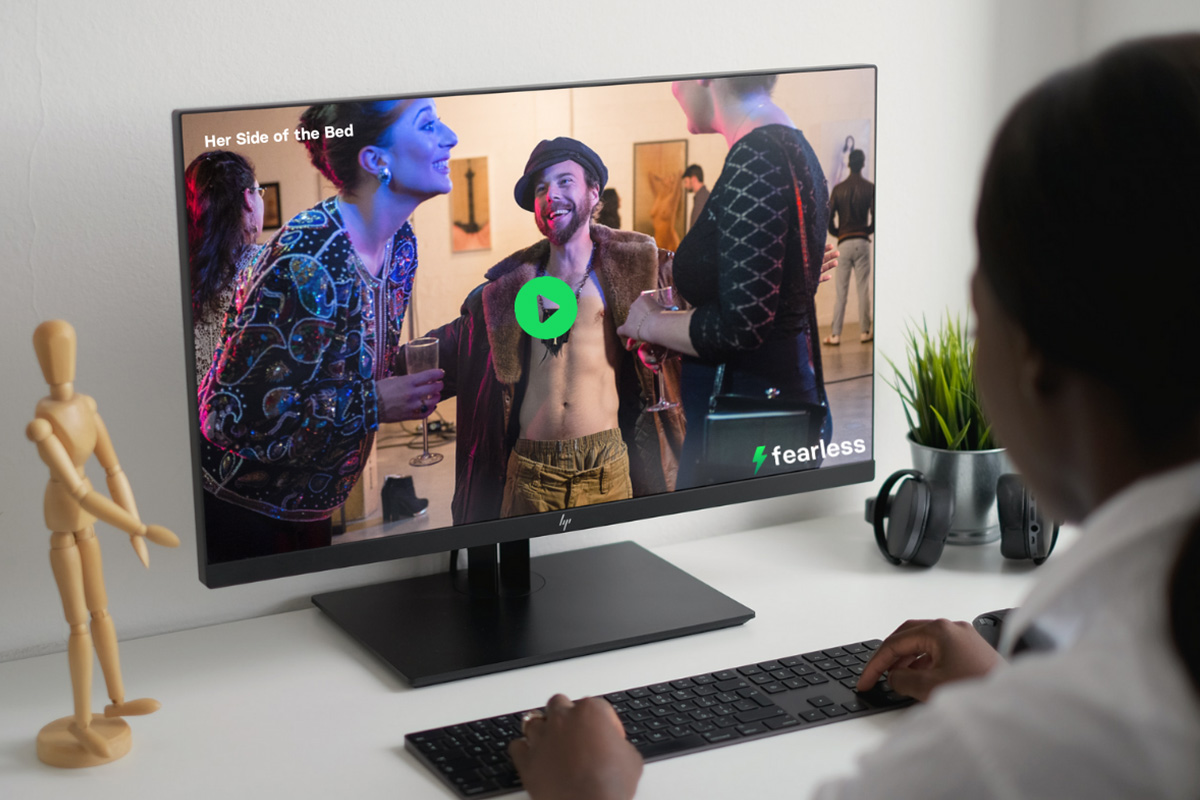
Invalid Date
What is augmented reality and what can we do with it right now?
Photo via JohnDWilliams on iStock
TL;DR: The tech industry is developing a frontier between virtual reality (VR) and live action. To better understand the concept, let's look at the history of augmented reality and some examples.
The digital world can streamline shopping, growing a business, and so much more. None of those things need to be limited to a purely virtual existence though.
Before springing into full virtual reality, sometimes a digital tweak is best. The history of augmented reality (AR) features an evolution of new products that continue popping up every day, each adding to what makes this hybrid technology so promising.
The release of the Apple Vision Pro has tech enthusiasts saying VR and AR are "the next big thing again." So let's explore the wide range of existing augmented reality uses and how it already influences fields as varied as navigation and personal fitness.
Augmented reality blends reality with the digital universe. From playful adventures in Pokémon Go to time-saving navigation applications, AR is transforming the way we perceive and interact with the world.
At its core, augmented reality is just the bridge between your tangible surroundings and the expansive digital realm. It's reality enhanced.
Unlike virtual reality (VR), which immerses users entirely in a computer-generated environment, AR changes your perception of the real world by overlaying digital information. All of this is done in real-time, too.
Let's look at one of the most talked-about examples that has shaped the industry—augmented reality smart glasses. While wearing a pair, your city's streets could become an urban playground with interactive guides popping up as you explore.
An AR timeline that features advancements such as fully functional smart glasses suggests the possibility of a future where digital tools and resources integrate seamlessly with the real world.
AR technology operates through devices like smartphones, tablets, heads-up displays, glasses, and headsets—each equipped with cameras and sensors that capture your real-world environment.
Sophisticated algorithms then merge the captured data with computer-generated graphics, creating an enhanced sensory experience, like in this Ancient Greece–based augmented reality app.

Like other incredible modern technology, augmented reality history began humbly with some tracing it back to the 1960s.
This was a pivotal era when computer scientists and visionaries first began conceptualizing the idea of merging digital information with the physical world.
The notion was groundbreaking, but the technology of the time was far from making it a practical reality.
In the early 1960s, computer scientist Ivan Sutherland laid the foundation for augmented reality with a system he called the Sword of Damocles. It was an enormous headset connected to a computer that was suspended from the ceiling.
Wearing this cumbersome headset, the user experienced simple computer-generated graphics that were superimposed on their view of the real world.
The graphics were primitive by today's standards, but the concept was revolutionary. Sutherland's work marks the birth of head-mounted displays (HMDs), a key component in the development of AR.
While the Sword of Damocles was a proof of concept from the earliest stages of augmented reality history, it revealed its potential and set the stage for further innovations.
Over the years, the evolution of computers, graphics processing, and miniaturization have all helped create an AR history timeline, allowing for more practical and applicable inventions to arise. Defining those inventions as AR, VR, or something else, that's another story.
Photos via Mika Baumeister and Uriel Soberanes on Unsplash
There’s a quick and easy way to understand the difference between augmented reality and virtual reality, and all it takes is the answer to this question: What do you see?
If the world around you is entirely digital, you’re in a virtual environment. If there’s a blend of real and digital, then it’s augmented reality. Both are immersive experiences, and both are growing with exciting new apps and software, but they can serve different purposes.
VR is like a ticket to a completely digital realm, a full immersion into a computer-generated environment where the physical world is entirely replaced.
When you put on a VR headset, you effectively step into another universe, whether it’s a video game, a simulated training environment, or a virtual tour of a distant land (or an apartment).
Everything you see, hear, and interact with in VR is a product of computer-generated wizardry, which is a more all-encompassing experience than you might have with one of our augmented reality examples.
VR's magic lies in transporting you to places and experiences that are totally detached from your immediate surroundings. You don’t need to be in a field to see a sweeping sci-fi vista in VR.

Photo via Tobias on Unsplash
AR doesn't aim to create an entirely new world but instead overlays digital elements onto your real-world view.
Think of it as wearing a pair of glasses that superimposes information, graphics, or objects onto what you see around you. This blend of digital and physical worlds has possibly made the history of augmented reality more user-friendly.
Whether you're viewing historical information about a landmark, turning your cat into a dragon with a TikTok filter, or following augmented reality Google Maps walking directions on your smartphone, this tech enriches your real-world experience.
For a formal deep dive into augmented reality history, use, and development—The 2023 Metaverse & AR Developer Bundle is only $30.
You might notice that companies like Meta and Apple are avoiding defining their products as strictly for AR or VR.
Apple is using the term "spatial computing," while other companies like Meta, Varjo, and Sony are using the term "VR with mixed reality" to describe new VR and AR headset technologies, according to CNET.
As everyday AR glasses are still a ways away, mixed reality seems to be as close as VR headsets and VR products can get to merging with the AR timeline for now.
You might have already started to notice a surge in augmented reality uses, from everyday entertainment on social media to exciting developments in sports or medicine. It’s no accident that all this is happening now.
Here are some of the underlying factors:
Augmented reality history has caught up with itself.
AR is no longer a concept of the future. It's a present-day technology that is reshaping how you can interact with the world, and there’s a whole lot going on behind the scenes.
The systems enabling augmented reality are intricate and diverse. Nonetheless, there are four main types of technology that have a major role in how AR works today.

Photo via Poplar.Studio
Throughout the history of augmented reality it has evolved into a transformative technology on par with generative AI with diverse applications across various industries.
Throughout augmented reality history, you can find great new products regularly popping up in gaming, navigation, education, retail, marketing, sports, wellness, and social media spaces.
Augmented reality gaming takes interactive experiences to a new level, where digital elements seamlessly blend with the real world.
From popular games like the aforementioned Pokémon Go to immersive augmented reality escape rooms, gaming is a frontier for AR innovation. These games encourage physical activity, exploration, and social interaction in the real world, but designing them is no cakewalk.
If you want to find out how to design your own AR game, try The Ultimate Learn Unity Game Development Bundle, which is only $30.
AR enhances our ability to navigate the physical world by overlaying digital information onto our surroundings. On this note, you can find some more augmented reality examples in the form of GPS apps, location-based guides, and interactive maps that are changing how we find our way.
Companies like Google use AR and VR to provide real-time directions, making it easier to explore new cities, find nearby points of interest, or figure out where the nearest taco shop is when you don’t have time to find someone and taco-bout directions.
To interact with navigation apps more safely on the road, check out some other cool tech, like this 9" wireless car display compatible with Apple CarPlay, Android Auto, and basic phone mirroring.
Throughout the history of augmented reality, it's been an increasingly great educational resource, offering tools to create more interactive and engaging lessons.
Whether it's exploring the solar system in 3D or practicing surgical procedures through AR simulations, learning is more immersive than ever. In the classroom, AR is used to bring history to life, teach complex scientific concepts, and engage students in ways that traditional textbooks cannot.
Some of the most telling augmented reality examples are the ones adding new dimensions to the world of retail.
Using these AR tools from Auglio and Zenni Optical alongside a growing world of fellow forward-thinking providers, you can try on clothes with a virtual mirror, find the perfect pair of glasses digitally, visualize furniture in your home, and receive additional product information by scanning barcodes.
For example, apps like IKEA Place let you actually see what furniture looks like in your home before you buy it. No more wondering if the space by your bed is narrow enough for the KNARREVIK or just wide enough to fit a MALM.
Marketers are putting AR to work, creating captivating campaigns. From augmented reality product packaging (like Zappar's) to advertising in the metaverse, it's enhancing augmented reality history and brand engagement.
Check out what AR author Helen Papagiannis thinks the "future of brand storytelling and immersive commerce looks like in Spatial Computing" in her deep dive into Gucci’s Apple Vision Pro campaign.
At a more basic level, interactive brochures, posters, and product labels allow customers to scan and unlock immersive content, turning passive advertising into dynamic brand experiences that audiences may actually enjoy, but it can be tough to learn all this on your own.
That’s why it’s important to take note of e-learning opportunities like these:
Augmented reality in art and design
AR for creatives represents a cutting-edge fusion of creativity and technology.
Whether it’s a designer transforming a static piece into an interactive experience, or a museum using augmented reality exhibits viewed through an app—augmented reality history could prove to redefine how we engage with the arts.
Augmented reality has scored a touchdown in the field of sports, whether it’s being used for training, live statistics, or enhancing the fan experience. Fans at sports events can access instant statistics, replays, and player data through their smartphones.
Meanwhile, fitness enthusiasts are enjoying custom AR fitness coaching, personalized workout routines, and real-time feedback, making exercise more engaging and effective. But it still won’t make burpees better—nothing ever will!
While not a full-on piece of AR technology, this CMax Lite Bluetooth Smartwatch can show you calories burned, heart rate, and more helpful metrics at a quick glance. It's only $40.
Love 'em or hate 'em, filters have become integral to the history of augmented reality and many social media platforms like Snapchat, TikTok, Instagram, and Facebook.
These features have become a defining element of modern social media, allowing users to engage with their followers in innovative ways.
Augmented reality continues to evolve at a rapid pace, and as a whole AR stands at an exciting crossroads, poised for a bright future. While certain challenges like hardware limitations, integration into daily life, and content development complexities exist, they are hurdles that innovation can overcome.
Modern devices have made significant progress. Continuing to innovate in terms of processing power, battery life, and form factor will make AR more accessible and user-friendly as time goes on.
Achieving widespread adoption by the general public and fostering a growing developer community will take a while, but as businesses invest in AR applications and new educational opportunities emerge, the history of augmented reality will continue to evolve.
StackSocial works with a variety of merchants and brands to bring you deals worth talking about. We may earn a commission on purchases made through our links. Prices subject to change.
Sign Up For Our Newsletter
Sign up to see our latest collections, exclusive offers & get 15% off.

Invalid Date

Invalid Date

Invalid Date

Invalid Date

Invalid Date

Invalid Date

Dec 27

Jul 12

Jun 28

Jun 19

Jun 12

Apr 2